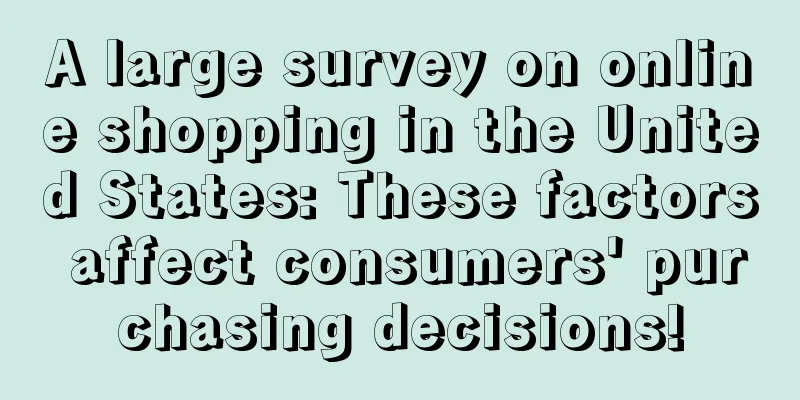The COVID-19 pandemic has not accelerated the development of e-commerce (foreign research report)

|
E-commerce penetration in the U.S. is currently at levels it would have been even without the pandemic. While Covid has boosted e-commerce spending in 2020, this acceleration may not be a step change after all. The 2020 lockdowns led to massive forced adoption of e-commerce and online groceries, with a lot of growth being pulled to the front. Online spending grew more than 40% in the second quarter of 2020, the fastest growth in decades. But as offline retail recovers, e-commerce's role in U.S. retail appears to be receding. Every year e-commerce gets a little bigger, and the pandemic made it even bigger for a while; but as things started to calm down, e-commerce is back on the trend line it’s been on for more than a decade. According to the U.S. Department of Commerce, e-commerce accounted for 12.4% of total retail spending in the third quarter of 2021; before the pandemic, it was expected to reach 12.6%, given the average growth over the past five years. Yet shoppers are still spending more online than historical trends would suggest. In the third quarter, e-commerce spending was $204 billion. Before the pandemic, it was expected to be $183 billion. E-commerce market share is almost the same as expected before the pandemic! Because offline retail spending is also surging - total retail spending is up 13%, after only 2-3% growth in the previous 20 years. Shoppers are spending more both online and offline. In the third quarter, Amazon reached sales levels it would have achieved even without the pandemic boost. Target, on the other hand, continued to grow strongly, driven by same-day delivery and pickup. Meanwhile, Shopify continued to accelerate, in part because it continues to add merchants. Some companies, and some geographies outside the U.S., are indeed seeing step-change changes. According to Adobe, total online spending in the U.S. on Black Friday was $8.9 billion, slightly down from $9 billion in 2020 and significantly below Adobe's expected range. In addition, Thanksgiving was flat year-over-year at $5.1 billion, marking the first time that online spending on Thanksgiving and Black Friday reversed the growth trend of the past few years and did not increase year-over-year. The pandemic is not over yet, and disruptions to global supply chains are creating new headwinds. It turns out that e-commerce penetration growth will look like a "J curve" - an economic theory that a period of adverse returns is followed by a period of gradual recovery that rises to a point above the starting point. Perhaps after the e-commerce boost in 2020, it is now deteriorating and will accelerate again in the future. Nonetheless, e-commerce will continue to build for the future. The physical infrastructure, including ports, warehouses, aircraft and transport, is expanding. Amazon and other companies are hiring hundreds of thousands of additional employees so that it will be better prepared when the next phase of change comes; but it will likely continue to grow at the same 14-15% average it had in the decade before the pandemic! |
Recommend
Amazon FBA FAQ (Part 4)
Image source: Tuchong Creative Quickly promote the...
Big recovery! European commission rates cut in half, customized products no longer eligible for return
Amazon Sales Commission Changes 01 According to A...
Here you go! The "king bomb" promotion plan made by the vice president of Shenzhen Amazon's super sales
What I want to share with you today is the Amazon...
Orders do not increase, but taxes do! Sellers will be taxed in many ways, is a price increase coming?
A seller joked: Since joining Amazon, his mentalit...
Amazon's low-price mall is coming? Can a $1.7 phone case with free shipping win over Temu?
Anonymous user My C position Amazon's low-pri...
The US government is reviewing Alibaba's cloud services, saying it is "concerned about national security risks"!
<span data-shimo-docs="[[20,"获悉,据路透社报道,拜登政...
What is Texun cross-border e-commerce finance and taxation? Texun cross-border e-commerce finance and taxation evaluation
Texun Cross-border E-commerce Finance and Taxation...
In order to retain talent, a cross-border retail giant lets its employees become “bosses”?
At present, with the formation and maintenance of ...
How should the performance bonus be set when a small team invests 1 million yuan to build a high-quality store? How can the development team maintain its enthusiasm?
Earn 100 million yuan from cross-border My C posit...
A true portrayal of Amazon sellers on Black Friday!
Cross-border Business School Information and skil...
Breaking news! SHEIN is at risk of being shut down in the US? Official response!
It is learned that after the U.S. Congress’ hearin...
What is 5miles? 5miles Review
5miles is a well-known e-commerce platform in the ...
What is Shunyou Logistics? Shunyou Logistics Review
Shenzhen Shunyou Cross-border Logistics Co., Ltd. ...
New feature to reduce return rate! Amazon supports buyers to contact sellers before sale~
Amazon has launched new features again recently! A...
Amazon sellers blast the one-day-off-and-two-day-off policy: I didn’t have a choice before, now I just want two days off
▶ Video account attention cross-border navigation ...









